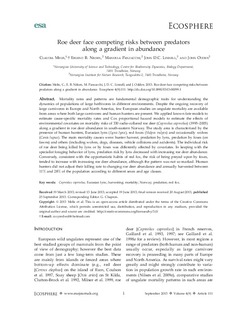| dc.description.abstract | Mortality rates and patterns are fundamental demographic traits for understanding the dynamics of populations of large herbivores in different environments. Despite the ongoing recovery of large carnivores in Europe and North America, few European studies on ungulate mortality are available from areas where both large carnivores and human hunters are present. We applied known fate models to estimate cause-specific mortality rates and Cox proportional hazard models to estimate the effects of environmental covariates on mortality risks of 330 radio-collared roe deer (Capreolus capreolus) (1995–2005) along a gradient in roe deer abundance in south-eastern Norway. The study area is characterized by the presence of human hunters, Eurasian lynx (Lynx lynx), red foxes (Vulpes vulpes) and occasionally wolves (Canis lupus). The main mortality causes were: hunter harvest, predation by lynx, predation by foxes (on fawns) and others (including wolves, dogs, diseases, vehicle collisions and accidents). The individual risk of roe deer being killed by lynx or by foxes was differently affected by covariates. In keeping with the specialist foraging behavior of lynx, predation risk by lynx decreased with increasing roe deer abundance. Conversely, consistent with the opportunistic habits of red fox, the risk of being preyed upon by foxes, tended to increase with increasing roe deer abundance, although the pattern was not so marked. Human hunters did not adjust their killing rate to changing roe deer abundance and annually harvested between 11% and 28% of the population according to different sexes and age classes. Capreolus capreolus; Eurasian lynx; harvesting; mortality; Norway; predation; red fox. | nb_NO |

